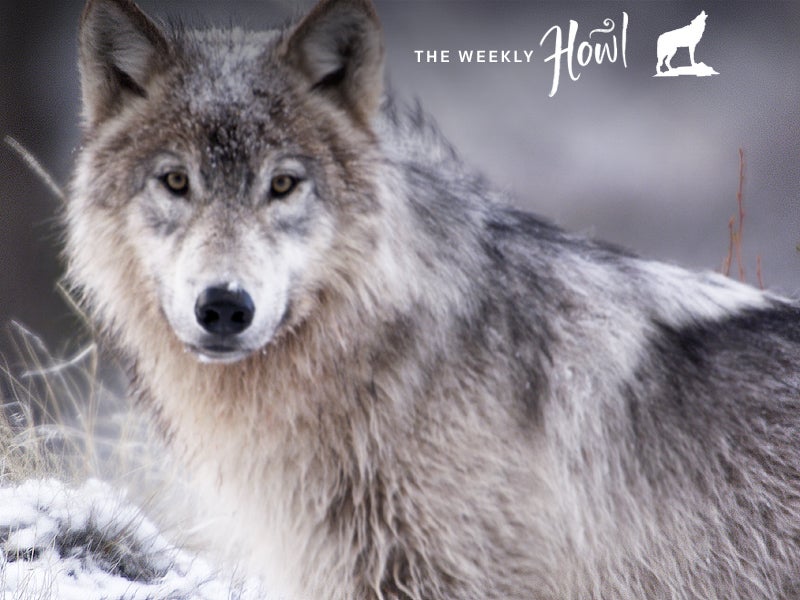Battle for the Wild: Confronting Idaho’s Controversial Wolf Management Practices
Isaac and Bjornen Babcock spent their year-long honeymoon in the central Idaho wilderness, documenting what it takes for wolf packs to survive and thrive. However, the greatest threat to wolves is not the natural challenges posed by long winters or food scarcity, but rather a controversial and secretive state-sponsored killing program.

This page was published 10 years ago. Find the latest on Earthjustice’s work.
Update, August 5, 2015: The Forest Service has notified us that Idaho will not resume wolf-killing in the Frank Church-River of No Return Wilderness during the 2015-2016 winter. See this letter from the Forest Service with the formal announcement.
When Isaac and Bjornen Babcock got married, they didn’t take a typical American honeymoon, spending a week on the beach in Hawaii or embarking on a cruise to the tropics. The couple instead ventured into the remote and pristine landscape of the Frank Church-River of No Return Wilderness in central Idaho to spend a year among the canyons, trees and wildlife.
Exploring “the Frank,” the couple encountered great beauty, including the small, gray Dipper bird, otters playing in untouched rivers and white-tailed deer bounding through the underbrush. They also found wolves. Isaac, a backcountry filmmaker and researcher, filmed members of nine wolf packs near the River of No Return playing, socializing and even trying their hand at hunting. The footage from the couple’s year in the wilderness was turned into a mini-documentary that appeared as an episode of the PBS program “Nature” in 2012.
In one scene, a female wolf gingerly carries her fluffy offspring up a hill too steep for the pups to manage alone. Intoning over footage of a wolf pack slipping from view, Isaac observes that wolves need a “place to live by their rules, not ours.”
Judging by the footage, the Frank Church-River of No Return Wilderness seems like the ideal place for wolves to thrive, far from the influence of man. However, in the very year the documentary debuted, it was discovered that the Idaho Fish and Game department had hired a wolf hunter to eliminate entire packs of wolves in the remote wilderness area.
Since Congress contentiously dropped Endangered Species Act protections for wolves in 2011, Idaho’s management of wolves has been rife with controversy. The state uses trapping and aerial gunning programs to thin wolf packs, claiming the need to bolster the elk population. However, Idaho’s own biologists have found that declining elk numbers are primarily due to deteriorating habitat for the elk, not wolf attacks.
During the winter of 2013 to 2014, Idaho’s hunter killed nine wolves. While staying in the area, the hunter occupied U.S. Forest Service facilities, though this program runs counter to the Forest Service’s mission to manage the wilderness as a place “where the earth and its community of life are untrammeled by man.”
Indeed, Idaho Fish and Game’s actions are inconsistent with the definition of wilderness as a place that, according to the 1964 Wilderness Act, “appears to have been affected primarily by the forces of nature, with the imprint of man’s work substantially unnoticeable.” The Frank Church-River of No Return Wilderness without a naturally functioning wolf population is no wilderness at all.
Learning of the state-sponsored culling program, Earthjustice stepped in on behalf of conservation organizations. Thanks to efforts led by Earthjustice attorney Tim Preso, the state suspended its wolf management program in the Frank Church Wilderness for the winter of 2013 to 2014. Before the following winter, Idaho released a more detailed plan specifying its intention to kill 60 percent of the wolf population in a portion of the wilderness area.
Preso pushed back against Idaho’s draconian wolf policy and on July 29, 2014, Idaho Fish and Game announced it would not hire a hunter for the winter of 2014 to 2015 either. But Idaho made no guarantees regarding subsequent winters. According to the terms of the agreement reached in the Earthjustice lawsuit, Idaho must notify the U.S. Forest Service by August 1, 2015 of its intentions for the winter of 2015 to 2016. The Forest Service must notify Earthjustice by August 5 of those plans and its assessment of them.
Reflecting on our success thus far, Preso said, “As we marked the 50th anniversary of the Wilderness Act last year, we were relieved that the Frank Church Wilderness would be managed as a wild place, rather than an elk farm, for at least the immediate future. Now we must make sure that wilderness values prevail for the long term.”
About this series
2015 marks the 20th anniversary of the reintroduction of gray wolves to the northern Rockies, and since that time wolves have been under nearly constant threat of losing their protections. The Weekly Howl provides insights and education about the gray wolf and updates on the status of its protections while celebrating the iconic species as a vital part of a functioning, healthy ecosystem. Posts will appear every Wednesday starting June 17 and running through the summer.
Don’t miss last week’s post: “How Wolves Saved the Foxes, Mice and Rivers of Yellowstone National Park.”
Established in 1993, Earthjustice's Northern Rockies Office, located in Bozeman, Mont., protects the region's irreplaceable natural resources by safeguarding sensitive wildlife species and their habitats and challenging harmful coal and industrial gas developments.